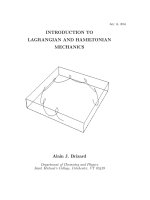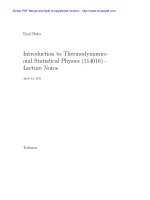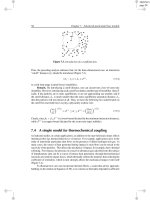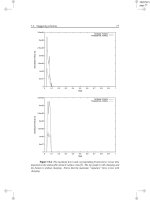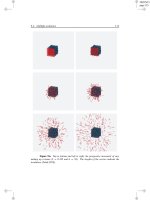An Introduction to Thermodynamics and Statistical Mechanics Second Edition pps
Bạn đang xem bản rút gọn của tài liệu. Xem và tải ngay bản đầy đủ của tài liệu tại đây (163.77 KB, 9 trang )
An Introduction to
Thermodynamics
and
Statistical Mechanics
Second Edition
Keith
Stowe
California Polytechnic State
University
,:~
CAMBRIDGE
UNIVERSITY
PRESS
Contents
Preface
List
of
constants, conversions, and prefixes
Part I Setting the scene
1 Introduction
Part
11
Small systems
2 Statistics for small systems
3 Systems with many elements
Part III Energy and the first law
4 Internal energy
5 Interactions between systems
Part IV States and the second law
6 Internal energy and the number
of
accessible states
7 Entropy and the second law
8 Entropy and thermal interactions
Part V Constraints
9 Natural constraints
10
Models
11
Choice
of
variables
12
Special processes
13
Engines
14
Diffusive interactions
Part VI Classical statistics
15
Probabilities and microscopic behaviors
16
Kinetic theory and transport processes in gases
17
Magnetic properties
of
materials
18
The partition function
page
vii
xii
1
3
23
25
40
63
65
79
99
101
117
135
153-
155
186
210
226
252
287
327
329
352
369
382
v
vi
Contents
Part
VII Quantum statistics
399
19
Introduction to quantum statistics
401
20
Quantum gases
422
21
Blackbody radiation
438
22
The thermal properties
of
solids
457
23
The electrical properties
of
materials
477
24
Low temperatures and degenerate systems
504
Appendices
531
Further reading
537
Problem solutions
538
Index
551
Index
absolute zero
approaching, 506-510
behaviors near, 175-176
acceptors,
483,488
activation energy, 297
adiabatic demagnetization, 508-509
adiabatic processes, 229-232
in ideal gas, 231-232
in photon gas, 449
temperature changes, 229
air, liquefaction of, 312-314
alloys, 314-315
angular momentum,
9,11-14,531
atomic magnets, 371-372
atomic vibrations, 457
average molecular speed, 355
band-edge equivalent states, 485-486
band structure and width, 477-479
bands
density
of
states, 486
in divalent metals, 480
overlapping, 479
unfilled, 479-481
valence and conduction,
192,477-479
Bardeen-Cooper-Schrieffer (BCS)
theory distribution, 518
bell curve,
see Gaussian
beta
(Ilk]), 332
bias, forward and reverse, 497
Big Bang, radiation from,
441,443
binary mixtures, 308-316
binomial expansion,
29,42
black holes, 520
blackbody emissivity, 442
blackbody radiation, 438-449
distribution, 439
energy density, 439-440
energy flux, 441-444
Bohrmagneton, 371
boiler, 273
Boltzmann statistics, 333
Boltzmann's constant, 72, 126, 138
Bose-Einstein condensation, 512-513
for fermion pairs, 517-518
Bose-Einstein statistics, 403, 423
bosons,
13
degenerate,
176,394,413,429,510,
512-519
occupation number,
403,423-425
relativistic and nonrelativistic, 403,
423-425
bound states,
15-17
Brownian motion, 342
canonical ensemble, 330
Carnot, Sadi, 265
Carnot
cycle, 265
efficiency, 266, 267
engine, 265-267
catalysts, 297
chain rule, 215
charge carriers, 483
mobility, 484
thermal excitation, 482
chemical equilibrium, 295-297
chemical potential,
81,83-84,
137,
288-291
and concentration, 288, 290
and heat released,
83-84
and nunlber
of
particles
and osmosis,
293-294
and particle distributions, 84-86
and phase space, 84
and potential energy, 288, 290
and the second
law,
288
at all temperatures, 431-433
calculation of,
391-392,411-414
classical limit, 431
dependence on
T,p,
168,288
from partition function, 388,394,
406-407,413
in low- and high-density limits, 394,
412-414
of
degenerate systems,
401,413-414,
429,430
bosons, 429, 513
fermions, 429, 430
of
nearly degenerate fermions,
432-433
chemical reactions, heat transfer, 144
classical1irnit, 431
classical probabilities,
333-334,336-337
classical statistics, 329-342
examples, 336-337
limits of,
386,409
needed ingredients,
402,413
when to use, 333
Clausius-Clapeyron equation,
299-300
coefficient
of
performance, 258
coefficient
of
utility, 267
cold packs, 309
collapsed star, size
of
collision frequency, 357-359
compressibility, 196
compression ratio, 275
Compton scattering, 6
condenser, 273
conduction band, 192, 193,
478
conduction electrons, 466-468
heat capacity, 468
thermal energy, 466-468
thermal properties, 457
conduction
electrical, 54-55
thermal, 79
conductors, 479-481
conserved quantities, 242, 362
551
I
I
I
I
552
constraints
first
law,
167-168
natural, 155-178
second
law,
158-165
second order,
160 162,
164
third
law,
166,175-177
types of, 157
zeroth
law,
166
contents,
v-vi
continuity equation, 242, 362
convection,
81
vertical, 229
cooling
by adiabatic demagnetization,
508-509
by throttling, 235-237
Index
by helium diffusion, 507
diffusive, 506-507,510,512-519
mechanical, 506-507
optical methods
for,
510
through expansion, 506 507
cosmic background radiation, 441,443,
449
critical point, 298, 302
Curie
law,
375
current density, 355
currents,
drift and diffusion, 494-496
cycles
gas and vapor, 260
open and closed, 260
Debye
cutoff, 460-461
energy,
461
frequency,
461
function, 462
model, 459-465
temperature,
461
degenerate levels, 104
degenerate systems, 175-177, 504
bosons, 510,512-519
conditions
for,
504
fermions, relativistic and
nonre1ativistic, 430
gases, 428
degrees
of
freedom,
71-72,74
and partition function, 389-390,
410-411
energy of, 342
in solids, 457
density
of
states, 10 11,105-110,
390-391
and internal energy, 105,390-391
and number
of
particles, 390-391
for gases, 402-405,422-432
Fermi gas, 486
phonon gas, 459
detailed balance
of
radiation, 440-441
diamagnetism, 369
diatomic gas molecules,
71
diesel engines,
271
differentials, exact and inexact, 88-91
diffusion, 83-87
across p-njunction, 494-496
diffusion equation, 362
diffusive cooling, 507-508,510,
512-519
diffusive equilibrium, 85-86
diffusive interactions, 83-87,287-316
and Gibbs free energy, 170-171
distinguishable subsystems, 386, 409
donors, 483,488
doped semiconductors, 482, 488-489
Doppler effect in cooling, 510
drift and diffusion currents, 494-496
Dulong-Petit
law,
339
effective mass
of
charge carriers, 486
efficiency
of
engines, 254, 266, 267
and reservoir temperatures, 266
Einstein model
boson systems, 513-519
for lattice vibrations, 459
elastic constant,
16
electrical charge,
5-6
electrical circuits, thermal noise in, 450
electrical conductivity, 484, 485,
486-487
in
semiconductors, 485, 486-487
temperature dependence of,
481
electrical current density, 483
electrical properties
of
materials, 497
electromagnetic waves,
6,
80
electronic devices, 494-497
electrons
and holes, 192-194
conduction, 192
valence, 192
emissivity, 442
energy distribution, 534
for large systems, 120-124
energy
fluctuations,
123
harmonic oscillator,
16
internal, 74
potential, 65-69
radiation, 440-444
thermal,
72-73,74
transfer, 79
engines, 252-275
Carnot, 265-267
coefficient
of
utility, 267
constraints, 254, 262
cycles, 262
efficiency, 254, 266
gas piston, 255-256
gas turbine, 257-259
increasing efficiency of, 274 275
internal combustion, 272
model cycles, 254, 262
perfo~ance
analysis of, 262-265
p-V
diagrams, 254
reversible, 266, 267
T
-S
diagrams, 254
types
of
cycle, 260
ensemble average, 330
ensembles, 26, 329-330
enthalpy
calculation of, 264
definition,
168
dependence on
(T,
p), 264
inthrottling process, 236
in performance analysis, 262-265
of
ideal gas, 264
properties of, 170
entropy, 126-130
and heat transfer, 136
and mixing, 308,309-315
and number
of
states, 126, 127
and reversibility,
233
and the second
law,
128
and the third
law,
142-145
and thermal interactions, 135-145
atT=0,142
definition of, 126
dependence on
(p,
V),
219
dependence on (T,p),
219
in binary systems, 308-310, 315
of
gases and solids, 129
of
ideal gas, 187
of
interaction, 308,309-310,315
of
many systems, 128
of
mixing, 308-315
of
photon gas, 449
of
solids,
187
equations
of
state, 187
for ideal gases and solids, 187-189
for liquids,
191
for real gases, 189-191
equilibrium, 102-103,158
diffusive, 85-86
the approach to, 158, 159-160
thermal,
13
7
equilibrium concentrations, 290-291
equilibrium constant, 296
equipartition, 71, 138-139,341-342
and van der Waals model, 218
heat capacities, 197-198
testing, 217-218
evaporation,
85
excitation temperature, 337
expansion
and internal energy,
82
free, 237-238
extrinsic variable, 136
factorials, 30-31
Fermi-Dirac statistics, 403, 423
Fermi energy, 177
degenerate fermions, 402, 413
Fermi gas model, 486-487
Fermi level, 176,458,489-490
in semiconductors, 485
temperature dependence of, 489-490
Fermi surface, 176,430
Fermi tail, 480-481
fermion gas, nearly degenerate, 467,
535-536
fermionpairs, 517-518
fermions,
13
degenerate, 176, 401-415
degenerate relativistic and
nonrelativistic, 430
nearly degenerate, 432-433
occupation number, 403, 423
relativistic and nonrelativistic, 403,
423-425
ferromagnetism, 370
first
law,
88, 135, 137
constraints, 167-168
definition,
88
fluctuations, 40-44,
123
in occupation number, 404-405,
426-428
at equilibrium, 162-164
in ideal gases, 164
relative,
43,
53
forward bias, 497
Fourier analysis, 7
amplitudes, 7
free expansion, 237-238
freezing and boiling points, 293
friction, 234
fundamental postulate, 103-104
gas cycle, 260
gas laws, in quantum gases, 404-405,
426-428
gas piston engines, 255-256
gas turbine engines, 271-272
gases
degenerate, 428
density
of
states, 402-405,422-432
diatomic,
71
ideal, 187,
188
liquefaction, 312-314
molar heat capacities, 196
molecular velocities, 352-354
partition function, 389-393,409
phonon, 192
pressure in, 357
properties of, 198-200
quantum, 402,404-405,422,
426-428
real as opposed to ideal, 189-191
relativistic,
111
relativistic and nonrelativistic, 403,
423
root mean square speed, 342, 355
states
for,
108,
11
0
gasoline engines, 269
gauges,
165
Gaussian distribution, 44-50
Gibbs free energy
and chemical equilibrium, 295
and phase transitions, 306
definition, 168
in binary systems, 309-315
properties of, 170-171
van der Waals, 303
Index
553
grand canonical ensemble, 330
gravitational energy in collapsed star,
521
greenhouse effect, 446-448
gyromagnetic ratio,
14
harmonic oscillator, 15-17
heat, 79
heat capacity, 337-339
at low temperature, 144
changes with
Vandp, 219-220
Debye model, 463
definition,
141
diatomic gases, 338
of
photon gas, 449
of
solids, 338-339,468-470
heat equation, 241-243,362
solution for, 243
heat
flux,
239
heat function, 170
heat pumps, 259-260
heat shields, 445-449
heat transfer, 79-81
and accessible states, 140
and entropy, 136
and diffusive interactions, 83-84
direction
of
flow,
158, 162
in chemical reactions, 144
heat, inexact differential, 90
helium
expansive heating, 237
liquid, 506
phase diagrams, 515
superfiuid, 515-516
helium diffusion, 507-508
refrigeration
by,
507
helium I and
IT,
515,516
phase transition, 516
helium III,
506,507,517
Helmholtz free energy, 384-385
and partition function, 384-385
definition, 168
properties of, 169-170
van der Waals, 302-303
holes, 193,372,483
hydrogen, expansive heating, 237
hysteresis, 305
ice, melting point, 300
ideal gases
adiabatic processes, 231-232
'I
'I
i
'I
I
,I
,I
I
_
554
ideal gases (cont.)
entropy, 187
equations
of
state,
188
identical particles, 105-107
and counting
of
states, 239
and entropy, 239
Index
and occupation number, 387-388,407
identical subsystems, 387-388,407
insulation by layered foils, 445-446
insulators, 482
integrals, standard, 534
interacting systems, 117-124
energy distribution, 534
interaction entropy,
308,309-310,315
interactions, 79-92
types of,
79
internal combustion engines, 272
internal energy, 74
and accessible states, 101-111
and chemical potential, 405-407,
428-433
dependence on
(T,p),
218
fluctuations in, 384
from partition function, 394,412-414
in gases,
69,
73
in liquids,
67,
69
in solids, 68,
73
integrated, 167
mean value, 384
quantum effects, 69-71
three ways to change,
88
intrinsic materials, 482
intrinsic variables, 136
interdependence, 168
isobaric processes, 226-228
isothermal compressibility, 196, 197
isothermal processes, 228-229
jet engines, 271-272
J oule-Thompson process, 235-237
kinetic theory, 352-364
lapse rate, 229
large numbers, tools for,
121
latent heat, 299
lattice energy, 462
low-temperature fluctuations, 463
lattice vibrations, 459-464
Debye model, 459-464
Einstein model, 459
law
of
mass action
chemical, 295-297
in semiconductors, 487
layered foils, 445-446
Lenz's
law,
369
liquid helium, 506,515-516
phase diagrams, 515
production of, 506, 507
liquids,
191
heat capacities, 197-198
potential energy in, 67
states
for,
110
low temperatures, 505-519
attaining, 506-510
measuring, 510-511
magnetic interaction energy,
15
magnetic moment, mean, 373
magnetic moments, 14-15,371-372,531
magnetic properties
of
materials, 369
magnetism, 369
low-temperature limit, 375
magneton, Bohr and nuclear,
371
mass, effective, 486
mass action, law of, 295-297,487
materials
electricaJ properties of, 497
magnetic properties of, 369
Maxwell, James Clerk, 6
Maxwell's relations, 172-175
Maxwell velocity distribution, 352-354
derivation, 172
meaning, 173-174
mean field models, 301-303
mean free path, 358
mean values,
26-27,31,43,354-355,
383-385,403,423
mechanical cooling, 506-507
mechanical interaction, 81-82
metals
divalent bands, 480
s- and d-bands,
481
microcanonical ensemble, 330
minerals and alloys, 314-315
miscible fluids, phase transitions,
312-314
mixing, 238-239
mixing entropy, 308-315
mixtures, 308-316
mobility, 484
models, 200
molar heat capacity, 141, 196
molecular diffusion, 359,361
momentum and wavelength, 6
motion, Brownian, 342
mUltiple occupancy, 388, 406-407
natural constraints, causes of, 158
nearly degenerate fermions, 432-433
neutron stars, 520
Niagara Falls, 289
nonequilibrium processes, 234-244
nuclear magneton,
371
Nyquist theorem, 450
occupation number, 402-405, 422-432
and fluctuations, 404-405,426-428
for bosons, 403, 423-425
for fermions, 403, 423
order parameter, 305
osmosis, 293-294
osmotic pressure, 294
Otto cycle, 269
paramagnetism, 369,373-375
parameters and constraints, 157
partial derivatives, 211-212,213-216
ratios, 216
particle distributions, 84-86,390-391
and second
law,
288
particle flux, 355-357
particle transfer, 83-87
and changes in temperature,
86
particle waves, 6
particles
direction
of
flow,
158, 162
distinguishable or identical, 105-107
partition function, 382-394
definition, 383
distinguisqable subsystems, 386,409
examples of, 394,412-414
for a gas, 389-393,409
for many subsystems, 386-388
for rotation, 390-391
for vibrations, 391-392,411-414
identical subsystems, 387-388,407
translational motion, 390,
411
phase diagrams, 298-299
vapor cycle, 272
phase equilibrium, 298-307
phase space, 9-10
and chemical potential, 84
and particle densities, 389-393,409
phase transitions,
73
first order, 304, 306
higher order, 304, 306
in minerals and alloys, 314-315
in miscible fluids, 312-314
Landau theory, 306
phonon gas, 459-465
density
of
states, 459
phonons, 191-192,459-465,518
distribution, 460
maximum energy, 460-461
photoelectric effect, 6
photon gas
adiabatic processes, 449
energy distribution, 439
entropy of, 449
heat capacity, 449
inside Sun, 443
photons, 438-440
chemical potential, 439
in oven, 438-440
occupation number, 439
Planck's constant, 6
p-njunctions, 494-497
diffusion across, 494
potential energy shift, 494
postulate, fundamental, 103-104
potential energy
and forces, 65-69
and phase transitions, 67,68
potential energy reference level,
67,
72
potential wells,
67,
68
in liquids,
67
pressure,
137
principle
of
detailed balance
of
radiation,
440-441
probabilities
air molecules in a room, 27, 31, 33,
36,44,49-50
and accessible states,
103
and configurations,
27
and entropy, 401,413-414
classical statistics, 333-334
closely spaced states, 340
coins,
27,29,33
criteria, 27,31
dice, 27,28
in small systems, 27-32
in statistics, review, 401,413-414
quantum statistics, 334
probability distributions, gases, 352-354
probability
of
being in a state, 330-332
processes, quasistatic,
103
p-Vand
T-S diagrams, 254
p-Vdiagram
for engines, 254
van der Waals model,
301
quantum confinement, 458
quantum effects, 5-17, 69-71
quantum gases, 402,422
chemical potential, 405-407,428-433
energy and particle distribution, 403,
423-425
gas laws, 404-405,426-428
internal energy, 404-405,426-428
mean values, 403,423
quantum probabilities, 334, 335
quantum states,
9-10
quantum statistics, 401-415
examples, 335
needed ingredients, 402, 422
when to use, 333
quarks, charge of, 6
quasistatic processes,
103
R-value, 240
radiation,
80
emission, absorption, reflection, 445
random walk, 50-55
Rankine cycle, 273-274
reaction rate, 297
reactions, chemical, 290
real gases, 189-191
refrigerators, 258
coefficient
of
performance, 258
reheat cycle, 275
relativistic gases, states
for,
111
relaxation time, 102, 235
reservoir,
331
hot and cold,
253
reverse bias, 497
reversibility, 232-234
and heat transfer, 233
root mean square, 44
rotation
Index
molecular, 69-70
partition function
for,
390-391
second
law,
85,125-126,288
statements
of,
125,
128
semiconductor devices, 494-497
semiconductors, 193,482-494
doped, 482,488-489
Fermi level in, 489-490
intrinsic, 482, 483-487
law
of
mass action, 487
n- and p-type, 488
transition
to
intrinsic, 491-492
small numbers, tools for,
121
small systems,
25-35,40-55
solar energy
flux,
443
solar spectrum, 441,443
solids
atomic vibrations in, 191-192
equations
of
state
for,
189
555
heat capacities of,
196,457,468-470
modeling
of,
191-194
states
for,
108, 109, 110
thermal properties of, 457-470
solubility gap, 312
solutions
and chemical potential, 291-292
and vapor pressure, 292-293
colligative properties, 291-294
freezing and boiling points, 293
special processes, 226-244
specific heat,
141
spectra
of
accessible states, 389-390,
4·10-411
spin, 12,13
down or up,
13
spin entropy, 508
spin quantum number,
13
spin-orbit coupling, 375
staged compressors and turbines, 275
standard deviation,
42-44,46,47,48,49
standard integrals, 534
standing waves,
15
stars, death
of,
519
states
accessible, 532-533
and energy distribution, 117-124
and heat transfer, 140
closely spaced, 340
correction for identical particles, 106
556
states (cont.)
description of, 16, 17
for a system, 101, 105-1lO
Index
for interacting systems, 117-124
for liquids,
11
0
for macroscopic systems, 120-124
for monatomic gas, 109
for polyatomic gas, 109
for solids, 108, 109,
11
0
per
particle, 107-lO9
probability
of
being
41,
330-332
spacing of, 104-105
spectrum of, 402, 422
statistical independence,
32-34
statistical mechanics, 4, 5
statistics, quantum
and
classical,
405-407,428-433
Stefan-Boltzmann constant, 442
stellar collapse, 519
steps, random walk,
50-55
Stirling's formula,
30,32,46,47,
107
stoichiometric coefficients,
295-296
storms, 230
stress, 361
sum over states,
390,411
Sun, 520
superconductivity, 517
supercooling, 303
superfluid, 516
superheating, 303
system, states for, 532-533
Taylor series, 45, 65,
531-532
temperature,
72,73,
135-139
and mixing, 309
and
occupation number, 403, 423
and
particle transfer,
86
definition, 135
low,
505-519
scales, 166
transition to intrinsic, 491
thermal conduction, 239-241
thermal conductivity in gases,
359,361,
430
thermal energy,
72-73,74
thermal equilibrium,
13
7
thermal interaction, 79-81
thermal inversion,
229-232
thermal motion
and
diffusion,
85,86
thermal noise, 450
thermal properties
of
solids,
457-470
thermal resistance, 240
series and parallel, 240
thermodynamical potentials, 168
thermodynamics, 4, 5
thermometers and gauges, 165
third law, 142
and
Helmholtz free energy, 385
constraints due to, 166,
175-177
statement of, 142
throttling process,
235-237,
506
thunderheads, 230
translational motion, partition function,
390,411
transport processes,
359-362
triple point, 165
turbines,
257-259,273
uncertainty principle,
7-9,16,17
vacancies, 483
valence band, 192, 193, 478
van der Waals' model, 190, 198-200,
301-303
and
equipartition, 218
vapor cycle,
260,272-274
phase diagram, 272
vapor pressure,
292-293
variables
changing,
211-217
choice of, 210-221
dependent
and
independent, 91, 156,
186,210
intrinsic and extrinsic, 136
velocity distributions in gases,
352-354
vibration
molecular,
69-70
partition function for,
391-392,
411-414
viscosity,
359,361
volume expansion,
196,197
water
freezing, 198
special properties of, 298
triple point of, 165
wave functions,
6
wave nature
of
particles, 6
wave number, 7
wavelength
and
momentum, 6
waves
particle, 6
superposition,
7
white dwarfs,
177,520
work,
81-82
and
internal energy, 81, 82
direction of,
158,162
inexact differential, 90
types of, 81,
83-84
work function, 170
Z, partition function, 383
zero-point energy, 16
zeroth law constraints, 166
zitterbewebung, 17
